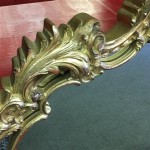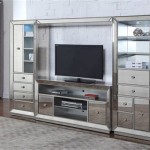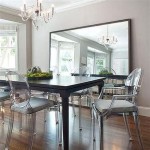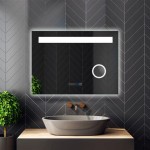Hanging a Lighted Mirror Securely on Drywall
The installation of a lighted mirror can significantly enhance the aesthetic and functional value of a room, particularly in bathrooms, dressing rooms, and vanity areas. However, successfully mounting such a fixture on drywall requires careful consideration of the mirror's weight, the type of mounting hardware used, and the condition of the drywall itself. Improper installation can lead to the mirror detaching from the wall, causing damage to the mirror, the wall, and potentially resulting in injury. This article provides a comprehensive guide to hanging a lighted mirror securely on drywall, focusing on best practices and essential considerations.
Determining the Weight and Choosing Appropriate Mounting Hardware
The initial and perhaps most critical step involves determining the exact weight of the lighted mirror. This information is typically provided by the manufacturer in the product specifications. Knowing the weight is crucial for selecting the appropriate mounting hardware. Lighted mirrors tend to be heavier than standard mirrors due to the integrated lighting components and the often more substantial frame construction. Standard picture hangers or small nails are unlikely to be sufficient for supporting the weight of a lighted mirror safely.
Several types of mounting hardware are suitable for hanging heavier items on drywall, each with varying weight capacities and installation methods. These include:
*Drywall Anchors:
These are designed specifically to provide a secure anchor point in drywall where studs are not accessible. There are several types of drywall anchors, including self-drilling anchors, plastic anchors, and toggle bolts. Self-drilling anchors are relatively easy to install and are suitable for lighter lighted mirrors. Plastic anchors require drilling a pilot hole and are often paired with screws. Toggle bolts offer the highest weight capacity among drywall anchors and are recommended for heavier mirrors. *Wall Studs:
Locating and utilizing wall studs is the most secure method for hanging heavy objects. Stud finders, either magnetic or electronic, can be used to identify the location of studs behind the drywall. Screws driven directly into a stud provide significantly greater holding power than any drywall anchor. *Heavy-Duty Picture Hanging Systems:
These systems often utilize specialized hooks or brackets that are designed to distribute the weight of the mirror over a larger area of the drywall. These systems can be a viable option for mirrors that are not excessively heavy.When selecting mounting hardware, it is imperative to choose items that are rated for a weight capacity that exceeds the actual weight of the lighted mirror. Adding a safety margin of at least 20% is a prudent practice. Furthermore, the quality of the hardware should be carefully assessed. Opting for reputable brands and durable materials, such as steel or heavy-duty plastic, will ensure a more secure and reliable installation.
The type of screw or nail used with the chosen anchor is equally important. The length of the screw or nail should be sufficient to fully engage the anchor and the mounting hardware on the mirror. The diameter of the screw or nail should match the specifications recommended by the anchor manufacturer. Using an undersized screw or nail can compromise the holding power of the anchor.
Preparing the Drywall and Installing the Mounting Hardware
Prior to installing any mounting hardware, the condition of the drywall should be thoroughly inspected. Drywall that is damaged, crumbling, or water-damaged will not provide a secure anchor point. Any existing damage should be repaired before proceeding with the mirror installation. Small holes can be filled with drywall compound, while larger areas of damage may require replacing the affected section of drywall.
Accurate measurement and marking are essential for ensuring proper mirror placement and alignment. Use a level to mark the desired location of the mirror on the wall. Then, carefully measure the distance between the mounting points on the back of the mirror. Transfer these measurements to the wall, marking the exact locations where the mounting hardware will be installed.
When using drywall anchors, follow the manufacturer's instructions carefully. For self-drilling anchors, simply screw the anchor directly into the drywall at the marked location. For plastic anchors, drill a pilot hole of the appropriate size before inserting the anchor. For toggle bolts, drill a hole large enough to accommodate the toggle wings, insert the bolt through the mirror's mounting hardware, attach the toggle wings, and then insert the assembly through the hole in the drywall.Once the toggle wings are inside the wall cavity, they will spring open, providing a secure anchor. Tighten the bolt until the mirror is flush against the wall, but avoid overtightening, which can damage the drywall.
If a stud is accessible, use a stud finder to locate its precise center. Drill a small pilot hole through the drywall and into the stud. Then, drive a screw of the appropriate length and diameter directly into the stud. Ensure that the screw penetrates at least one inch into the stud to provide adequate holding power. Using a level is crucial throughout this process to ensure the mirror is straight.
For heavy-duty picture hanging systems, follow the specific instructions provided by the manufacturer. These systems typically involve attaching specialized brackets to the wall using screws and anchors. The mirror then hangs from the brackets. Distributing the weight across multiple points can improve the overall stability of the installation.
Addressing Electrical Connections and Safety Precautions
Lighted mirrors require an electrical connection to power the integrated lighting elements. Before commencing any electrical work, it is absolutely essential to turn off the power to the circuit at the breaker box. This will prevent the risk of electric shock. Using a non-contact voltage tester is a safe way to confirm that the power is indeed off before touching any wires.
The method of connecting the mirror's electrical wiring to the building's electrical system will depend on the mirror's design and the existing wiring in the wall. In some cases, the mirror may be designed to plug into a standard electrical outlet. In other cases, the mirror may need to be hardwired directly into the electrical circuit. If hardwiring is required, it is strongly recommended to consult with a qualified electrician. Incorrect wiring can create a fire hazard or damage the mirror.
When making electrical connections, use appropriate wire connectors, such as wire nuts or crimp connectors, to ensure secure and insulated connections. Always match the wire gauge of the mirror's wiring to the wire gauge of the building's wiring. Using undersized wiring can cause overheating and pose a fire risk. Grounding the mirror is also crucial for safety. Ensure that the mirror's grounding wire is properly connected to the building's grounding system.
If the electrical wiring is located behind the drywall, it is important to protect the wires from damage. Use electrical boxes to enclose the wiring connections and prevent them from coming into contact with the drywall or other materials. Secure the electrical boxes to the studs or other structural supports.
After completing the electrical connections, carefully reinstall the mirror onto the mounting hardware. Ensure that the mirror is securely attached and that the wiring is not pinched or strained. Turn the power back on at the breaker box and test the lighting to ensure that it is functioning properly.
Finally, after the mirror is installed, it is also important to periodically check that the mirror is still securely mounted, especially in high-traffic areas or areas where the mirror may be subject to vibration or impact. If any loosening is detected, the mounting hardware should be tightened or replaced as needed.

How To Hang A Heavy Mirror On Drywall Stas Picture Hanging Systems

How To Hang A Heavy Mirror On Drywall Stas Picture Hanging Systems

How To Hang A Heavy Mirror Diy Family Handyman

How To Hang A Heavy Mirror Or Picture True Value

How To Hang A Mirror The Best Way On Drywall

Installation And After Care Guide Led Vanity Mirrors Ledmyplace

How To Hang A Heavy Mirror On Drywall

How To Hang A Large Or Heavy Mirror

Using Command Strips For Hanging A Mirror The Morris Mansion

How To Hang A Heavy Mirror Securely Bob Vila








